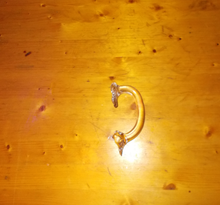Handle

A handle is a curved handle that is attached to pots , cups , glasses or other crockery in a vertical or horizontal position . In most cases, both ends of this handle are connected to the harness.
Longer handles that are only attached to the dishes at one end (e.g. pans and saucepans) do not come under the term handle.
However, the handles of buckets , bags and bags are also known as handles. Is named after its grip of the pail .
The handle as an artistic design problem
With the handle of a work of art, e.g. B. a Greek vase , this extends according to Georg Simmel "vividly into the world of reality, that is, the relationships to everything outside that do not exist for the work of art as such." The handle can or also be shaped as an organic part of the work of art Through its appearance, it makes its practical function “haunting” and thus distanced itself from the work of art like a picture frame. This distance is emphasized even more in the "frequent form: that the handle is designed as a snake, lizard, dragon" and creeps up to the work of art, so to speak.
etymology
The word “handle” is related to the verb “hang”.
literature
- Georg Simmel: The handle. In: Philosophical Culture. 2nd edition Alfred Kröner, Leipzig 1919, pp. 116–124 ( socio.ch ).
Individual evidence
- ↑ handle. In: Jacob Grimm , Wilhelm Grimm (Hrsg.): German dictionary . tape 10 : H, I, J - (IV, 2nd division). S. Hirzel, Leipzig 1877, Sp. 987 ( woerterbuchnetz.de ).
- ↑ See Otthein Rammstedt : Georg Simmel 'Henkel Literature'. An approach to the essayist. In: Essayism around 1900. Edited by Wolfgang Braungart , Kai Kauffmann. Winter, Heidelberg 2006, pp. 177-191.

